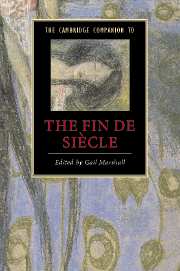Book contents
- Frontmatter
- Introduction
- 1 Psychology at the fin de siècle
- 2 Decadence and aestheticism
- 3 Sexual identity at the fin de siècle
- 4 Socialism and radicalism
- 5 Empire
- 6 Publishing industries and practices
- 7 The visual arts
- 8 The New Woman and feminist fictions
- 9 Realism
- 10 The fantastic fiction of the fin de siècle
- 11 Varieties of performance at the turn of the century
- 12 Poetry
- Guide to further reading
- Index
- Series List
7 - The visual arts
Published online by Cambridge University Press: 28 September 2008
- Frontmatter
- Introduction
- 1 Psychology at the fin de siècle
- 2 Decadence and aestheticism
- 3 Sexual identity at the fin de siècle
- 4 Socialism and radicalism
- 5 Empire
- 6 Publishing industries and practices
- 7 The visual arts
- 8 The New Woman and feminist fictions
- 9 Realism
- 10 The fantastic fiction of the fin de siècle
- 11 Varieties of performance at the turn of the century
- 12 Poetry
- Guide to further reading
- Index
- Series List
Summary
In his famous analysis of Britain in the 1890s, Holbrook Jackson saw the fin de siècle as a transitional point between the rule-bound certainties of Victorian society and the revolutionary ethos of modernism. This cultural melange of old and new is especially prevalent in the visual arts of the last decades of the nineteenth century, when worship of a mythic past conspired with a zeal for novelty. British artists during this period engaged with the same issues as their Continental counterparts, but their versions of fantasy and neophilia were unique: the same decades witnessed James McNeill Whistler's attenuated poetic visions of the Thames; Frederic Leighton's monumental reconstructions of the classical past; the novel, yet medievalising, furniture designs of William Morris and the Glasgow School; Burne-Jones's languid androgynous figures; and Aubrey Beardsley's perversely erotic drawings and engravings. Despite many artists' professed rejection of both tradition and the ugliness of the modern world, the visual artists of the fin de siècle shared with literature an engagement with prevalent ideas: the legacy of Charles Darwin, the economic critique of Karl Marx and the psychological concerns of the generation that preceded Sigmund Freud. Artists abandoned Darwin's scientific naturalism, but were drawn constantly to organic forms and the negative implications of natural selection - that is, the extinction of a decadent species, rather than survival of the fittest. The inspiration of Marx and his English followers led artists to consider craft and furniture-making as a newly dignified part of their profession. A pan-European obsession with neurosis and anxiety found its way into the tense mood and hermetic subject matter of many prints, drawings and paintings.
- Type
- Chapter
- Information
- The Cambridge Companion to the Fin de Siècle , pp. 131 - 152Publisher: Cambridge University PressPrint publication year: 2007

